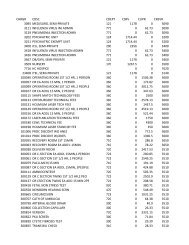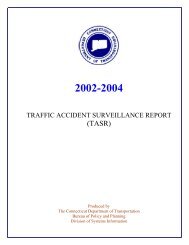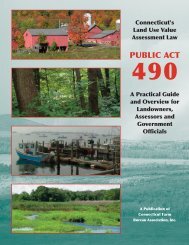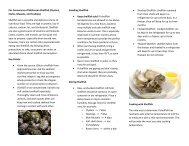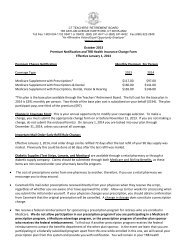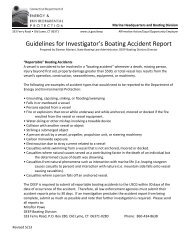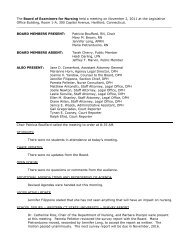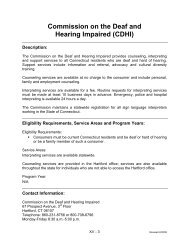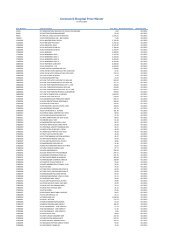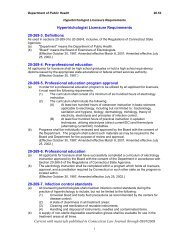Bronchiolitis Obliterans fact sheet - CT.gov
Bronchiolitis Obliterans fact sheet - CT.gov
Bronchiolitis Obliterans fact sheet - CT.gov
You also want an ePaper? Increase the reach of your titles
YUMPU automatically turns print PDFs into web optimized ePapers that Google loves.
HEALTH ALERT<br />
<strong>Bronchiolitis</strong> <strong>Obliterans</strong> in Workers<br />
Exposed to Food Flavorings<br />
Recently, several investigations have identified clusters of workers diagnosed with bronchiolitis obliterans<br />
(commonly referred to as “popcorn workers’ lung” and “flavorings-related lung disease”), a form of fixed,<br />
irreversible airway obstruction, after exposure to mixtures of butter flavoring chemicals. Evaluations of<br />
these workers revealed high rates of both severe respiratory symptoms and significantly compromised<br />
lung function. 1 These investigations concluded that there is a risk for occupational lung disease in<br />
workers with inhalation exposure to butter flavoring chemicals. 2 Other investigations have also shown that<br />
workers that use or manu<strong>fact</strong>ure certain food flavoring additives have developed similar health problems.<br />
Diacetyl and Other Food Flavorings Used in Food and Flavoring Manu<strong>fact</strong>uring<br />
Food flavorings can be either natural or manmade. Some are comprised of only one ingredient, but<br />
others are complex mixtures of several substances. Diacetyl is a chemical used in the manu<strong>fact</strong>ure<br />
of butter flavoring and other food flavorings and is the suspected cause of several cases of bronchiolitis<br />
obliterans in workers. During the manu<strong>fact</strong>uring process, workers may be exposed to food flavorings in<br />
the form of vapors, dusts, or sprays. There are many different types of food flavorings and most have not<br />
been tested for respiratory toxicity. However, recent animal studies of diacetyl exposure conducted by the<br />
National Institute for Occupational Safety and Health (NIOSH) have shown an association between<br />
diacetyl and fixed obstructive pulmonary disease.<br />
What are the health effects associated with flavorings-related lung disease?<br />
Exposure to certain airborne food flavorings is associated with higher rates of respiratory symptoms such<br />
as coughing, shortness of breath, fatigue, and difficulty breathing with exertion or exercise. Other adverse<br />
health effects may include eye, nose, throat, and skin irritation. There is some evidence that asthma,<br />
in some instances, may be associated with workplace exposure to certain types of food flavorings. 3<br />
Individuals with flavorings-related lung disease typically have respiratory symptoms and/or abnormal<br />
spirometry findings of fixed airways obstruction that does not improve with asthma medication. These<br />
symptoms may vary from mild to severe. Usually symptoms progress gradually, but in some cases<br />
severe symptoms can occur suddenly. Unlike some work-related respiratory conditions, symptoms<br />
associated with flavorings-related lung disease usually do not get better when employees leave the<br />
workplace.<br />
How to determine if an individual has flavorings-related lung disease?<br />
There are several tools available to diagnose flavorings-related lung disease.<br />
Typical diagnostic testing for bronchilolitis obliterans includes:<br />
• Diffusing capacity of the lung, which is generally normal, especially<br />
early in the disease<br />
• Chest x-rays, which are often normal but may show hyperinflation<br />
• Spirometry findings of fixed airway obstruction/restriction<br />
• High resolution computerized tomography scans (<strong>CT</strong> or CAT scans)<br />
may show air trapping and thickening of the airway walls<br />
• Biopsy of the lungs may show narrowing or complete<br />
obstruction of the small airways when the tissue is examined<br />
under a microscope 3<br />
Small airway with obstruction in bronchiolitis obliterans<br />
(Photo obtained from the European Respiratory Society Journals)<br />
How to determine if a patient is at risk for flavorings-related lung disease?<br />
As with any individual presenting with respiratory symptoms, it is important to take a complete<br />
occupational history in order to determine what role, if any, the workplace may have in an individual’s<br />
specific respiratory condition. This includes not only asking patients where they currently work, but also<br />
where they worked in the past, what they did at each of their workplaces, and what chemical, dust, or<br />
other hazards they were exposed to at work.<br />
Conditions may exist for significant exposures to food flavoring substances in facilities that manu<strong>fact</strong>ure or<br />
utilize food flavorings as part of their processes. Any individual working in one of these facilities may be at<br />
risk for flavorings-related lung disease, but it is expected that workers directly exposed to manu<strong>fact</strong>uring<br />
processes involving food flavorings are most at risk.
Connecticut Department of Public Health<br />
Environmental and Occupational Health Assessment Program<br />
410 Capitol Avenue, MS # 11OSP<br />
P.O. Box 340308<br />
Hartford, <strong>CT</strong> 06134-0308<br />
(860) 509-7740<br />
http://www.ct.<strong>gov</strong>/dph<br />
What should physicians do if they identify an individual with<br />
flavorings-related lung disease?<br />
Physicians in Connecticut who diagnose a case of flavorings-related lung disease should contact the<br />
State of Connecticut Department of Public Health, Occupational Health Unit at (860) 509-7740.<br />
In addition, Connecticut State Law requires that physicians diagnosing any work-related illness complete<br />
a Physician’s Report of Occupational Disease form, and submit that form to the Connecticut Departments<br />
of Labor and Public Health within forty-eight hours of recognition of that condition. Submission of this<br />
information is required by Connecticut General Statute (CGS) § 31-40a, confidential under CGS § 19a-25<br />
and exempt from HIPAA restrictions according to 42 CFR § 164.512(a-b). A copy of the Physician’s<br />
Report of Occupational Disease form can be found on the Connecticut Department of Public Health<br />
website at http://www.ct.<strong>gov</strong>/dph<br />
Additional Resources:<br />
U.S. Department of Labor Occupational Safety & Health Administration (OSHA)<br />
www.osha.<strong>gov</strong>/SLTC/flavoringlung/index.html<br />
National Institute for Occupational Safety and Health (NIOSH),<br />
www.cdc.<strong>gov</strong>/niosh/topics/flavorings/<br />
The Flavor and Extract Manu<strong>fact</strong>ures Association of the United States (FEMA)<br />
www.femaflavor.org/html/public/RespiratoryRpt.pdf<br />
California Department of Health Services<br />
http://www.dhs.ca.<strong>gov</strong>/ohb/flavorings<br />
Comprehensive Listing of Related Documents<br />
http://defendingscience.org/case_studies/Documents-for-Popcorn-Workers-Lung.cfm<br />
References:<br />
1. Kreiss K. et al. “Clinical bronchiolitis obliterans in workers at a microwave-popcorn plant”. New<br />
England Journal of Medicine 347.5(2002): 330-330.<br />
2. National Institute for Occupational Safety and Health (NIOSH) Health Hazard Evaluation Report, HETA<br />
2000-0401-299, (2006, January).<br />
3. Preventing Lung Disease in Workers Who Use or Make Flavorings. US Department of Health and<br />
Human Services (DHHS), National Institute for Occupational Safety and Health (NIOSH) Publication No.<br />
2004-110, (2003).<br />
Information contained within this <strong>fact</strong> <strong>sheet</strong> was extracted in part from the U.S. Department of Labor Occupational Safety & Health Administration (OSHA),<br />
the Flavor and Extract Manu<strong>fact</strong>ures Association of the United States, and the National Institute for Occupational Safety and Health (NIOSH)




